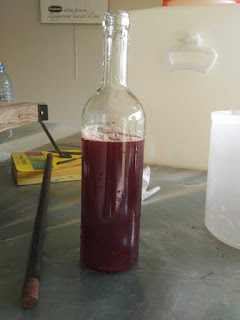As noted in our previous post 'Fun in the vineyard 2' we had a bit of a disastrous year what with mildew (despite a comprehensive spraying programme) and for the first time, bird depredations. We estimated only a quarter of white grapes and no red to speak of at all.
 |
| Cris himself |
On our first trip to Hatfield we saw Maccabeo, Trebbiano. Tempranillo, Sangiovese, Montepulciano, Cabernet Sauvignon and Merlot. We decided to buy Maccabeo as it looked a good deal riper than in 2016 and Chris said he was hoping for Nero di Troia and that really sounded just the ticket.
In the event, the Maccabeo sold out before we could get our hands on it and the Nero di Trois never materialised.
 |
| Moscato grapes transported from Hatfield. |
 |
| Grape crusher ready to go. |
 |
| Trebbiano grape juice |
By the same token, is our Moscato perhaps Moscato di Trani? Chris said he would ask the supplier but there has been no answer yet.
The Trebbiano was first and eventually started to ferment spontaneously.
A week later we repeated the crushing and pressing with the Moscato. Surprisingly this didn't seem to want to ferment on its own so we added a yeast angled towards making a Bordeaux white type wine. Did they mean Bordeaux white as in a Barsac or Sauternes or a dry Bordeaux white a la Sauvignon/Semillon? It probably doesn't matter much; the Moscato reacted immediately and somewhat violently to the sprinkling of this yeast after a week of just sitting there.
 |
| these two basket containes Bacchus grapes. |
 |
| note the pink Souvignier Gris grapes on top |
A few weeks later we harvested what we could from the vineyard. Bacchus is the predominant variety but this year there wasn't even enough for a 23 litre carboy. Fortunately some of our other varieties - all PIWI disease-resistant hybrids - have finally come on stream so we were able to supplement the Bacchus with Solaris (overripe), GM1807-3 (slightly underripe) which we call 'Bettina' after Dr. Bettina Lindner at Geisenheim who kindly helped us on our visit there a few years ago, Johanniter which has proved a good variety needing no spraying, Goldriesling (productive but mildew-prone) and surprisingly, Souvignier Gris, one of the more recently planted varieties which suddenly decided to produce nice big pink berries.
 |
| Racking the Gemischte Satz juice |
We have decided to call this wine 'Gemischter Satz.'
 |
| Trebbiano in the fermenter |
Gemischter Satz looks a bit dirty to begin with and the juice tasted markedly more acidic than the Italian ones not surprisingly. A week into fermentation it was giving off a nasty sulphurous aroma. We thought it had gone off. Always loeath to add sulfites, we thought on this occasion it might be the only thing to do. A week and 3 Campden tablets later, the smell had gone and the colour was looking a lot cleaner. The fermentation had pretty well finished so we racked the wine off leaving some pretty mucky residue.
 |
| left to right, Trebbiano, Gemischte Satz, Moscato |
 |
| the same 2 weeks later. Note changes in colour, transparency. |
We have topped this carboy up with some Bacchus from 3 years ago and a bit of Sauvignon blanc for want of anything more appropriate.
We very much wanted to make a red wine also. There were grapes from Rondo, Regent, Dornfelder and one or two others (a bunch each of Pinot Noir and Pinot Meunier) as well as Triomphe which as described in the prevuious pest (Fun in the vineyard 3) were eaten by birds.
Rondo is always the first to ripen and the first to be eaten by birds.
and here are the stalks after de-stemming by hand.
Here are the berries
 |
| Rondo microscopic vinification |
and here the microscopic vinification. Pathetic.
 |
| Gemischte Satz must |
In the end we added the Rondo grape juice to a left-over bit of our Trebbiano wine.








No comments:
Post a Comment